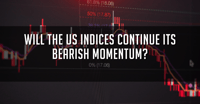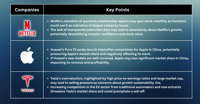The main focus this week will be the non-farm payroll. Will it boost or dampen December rate hike expectation?
Last week’s volatility in the market were driven mostly by events rather than data. Clinton beat Trump in their first presidential debate. It was not a “significant” victory, as Trump did not lose badly. Both parties still stand an equal chance of winning the election, which means uncertainties will continue to plague the markets. Judging from the reactions seen in the markets, we have made a simple conclusion. A swing towards Clinton favours the dollar, where else a swing towards Trump weakens the dollar. Their next debate is scheduled for 9 October. If Trump is able to turn the table around, the bear is likely to return to the market.
A commercial bank hit the headlines last week; Deutsche Bank’s share price plunged to all-time low. The German bank was slapped with a 14 billion dollar claim by US Department of Justice on investigations related to mortgage securities. German Chancellor Angela Merkel’s recent comments ruled out any bailout for the bank from the government, struck fear in investors. Without any bailout, many feared Deutsche may face cash issue and unable to tide over this crisis. Many investors pulled out their funds. If this situation continues, Deutsche may face the greatest fear of all banks – a bank run, which could possibly trigger a domino effect throughout Europe and the rest of the world.
After months of speculations, OPEC has finally agreed to reduce production to as low as 32.5 million barrels a day. The current output is close to 34 million barrels a day. This is the first time in 8 years OPEC has agreed to such a deal. WTI rallied beyond $48 per barrel. The reason why we did not see a strong rally towards $50 is because the deal did not include non-OPEC countries. Non-OPEC countries will have to play ball as well in order to benefit from the rising Oil price. Central banks around the world, who are struggling to hit their inflation target, welcomed such a move. If there are further actions to ensure oil price goes and maintains beyond $50, central banks could possibly see inflation edging closer to their targets.
The Aussie is fluctuating between 0.76 and 0.77 cent. As it stands now, there are enough uncertainties looming around. Reserve Bank of Australia is unlikely to rock their own boat, we expect them to maintain interest rate and their neutral stance in their upcoming statement. Fed will continue to hog the lime-light as they are the only major central bank in the world we have a chance of seeing a rate hike this year. Investors around the world will be looking at the non-farm payroll this Friday to speculate on a rate hike in December. A figure beyond 165K is likely to give the greenback some push.
Our Picks
EUR/USD – Slightly bearish. A pennant has formed in the H1 chart. If price breaks below the immediate support around 1.1225, may consider going Short.

GBPJPY – Slightly bullish. The support around 130 should hold. The downside risk would be disappointing PMI data this week.

XAU/USD (Gold) – Slightly bearish. Possible to consider placing a pending Short order below the support around 1309 in anticipation of a favourable non-farm payroll.

Top News This Week (GMT+8 time zone)
Australia: Cash Rate. Tuesday 4th October, 11.30am.
We expect figures to come in at 1.5% (previous figure was 1.5%).
UK: Services PMI. Wednesday 5th October, 4.30pm.
We expect figures to come in at 52.3 (previous figure was 52.9).
US: Non-farm employment change. Friday 7th October, 8.30pm.
We expect figures to come in at 168K (previous figure was 151K).
Fullerton Markets Research Team
Your Committed Trading Partner













